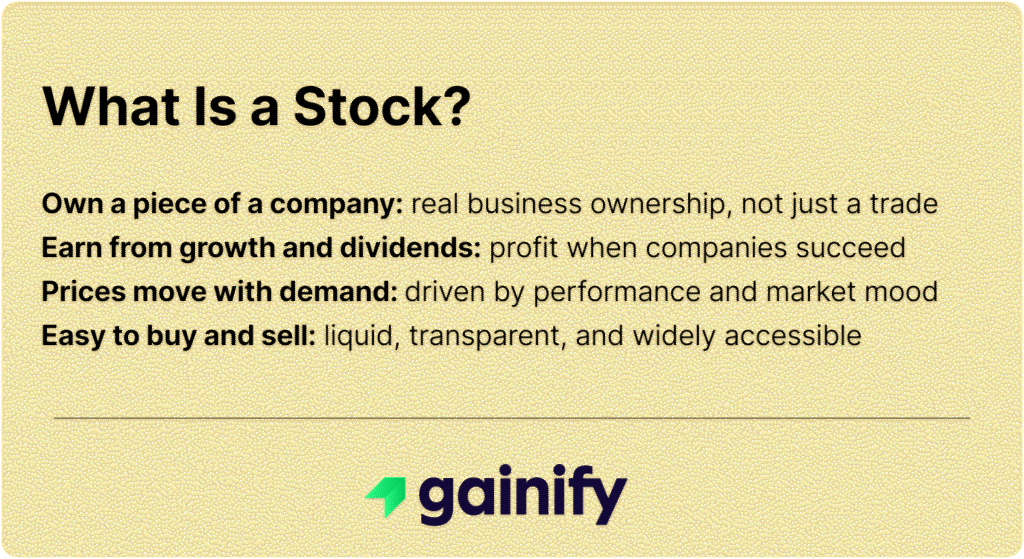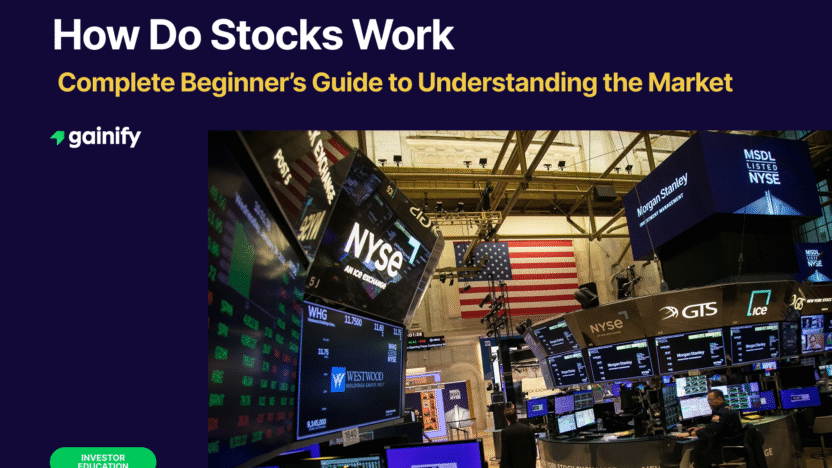Stocks are one of the most powerful ways for everyday people to build long-term wealth. When you buy a stock, you are purchasing a tiny slice of a real business – a company that makes products, earns revenue, employs people, and ideally grows over time. That ownership gives you a chance to share in the company’s success through profits, dividends, and an increase in share value.
Yet for many new investors, the stock market can feel complex or intimidating. Words like “equity,” “volatility,” or “valuation” may sound technical, but the basic concept behind stocks is straightforward.
This guide breaks it down step by step, explaining how stocks actually work, why companies issue them, and how investors can use them to build wealth over time.
Highlights
- Stocks represent ownership in a real business.
- Companies issue shares to raise money for expansion and growth.
- Investors make money through price appreciation and dividends.
- Stock prices are influenced by supply, demand, and company performance.
- Long-term investing and diversification are the most reliable paths to success.
What Is a Stock?
A stock represents a share of ownership in a company.

When a business wants to grow, it can sell pieces of itself to investors in the form of shares. Each share gives its owner a small stake in the business and, in many cases, voting rights in company decisions.
If you buy a share of Apple or McDonald’s, you become a part-owner of that company. While your ownership may be tiny, it gives you the right to benefit when the company performs well through rising stock prices or dividends.
Publicly traded stocks are listed on exchanges such as the New York Stock Exchange (NYSE) or Nasdaq, which allow investors to buy and sell them quickly at transparent prices. This liquidity is what makes stocks one of the most accessible investments in the world.
When you own a stock, you are not gambling. You are investing in the company’s ability to create value and earn profits over time.
Why Companies Issue Stocks
Companies issue stock to raise money for growth and expansion. This is often more flexible than borrowing from a bank. By selling shares, a company brings in capital to build new factories, develop technology, or enter new markets.
The process usually begins with an Initial Public Offering (IPO), where a private company offers shares to the public for the first time. Once listed, those shares trade freely on the stock market.
Issuing stock helps a business:
- Fund expansion without taking on too much debt
- Attract investors and increase visibility
- Reward employees with stock options or performance incentives
However, becoming a public company also adds accountability. Firms must publish financial reports every quarter and comply with strict disclosure rules. This transparency helps investors make informed decisions.
How Investors Make Money from Stocks
Investors earn returns from stocks in two main ways:
a. Price appreciation
When a company grows and profits increase, demand for its shares often rises. If you bought a share for $100 and it climbs to $150, your investment has gained $50 per share if you sell.
b. Dividends
Many established companies regularly pay part of their profits to shareholders as dividends. For example, Coca-Cola and Johnson & Johnson have paid dividends for decades. These payments can provide steady income, especially when reinvested into more shares.
In the long run, holding quality companies allows you to benefit from both capital growth and compounding returns. Even small, consistent gains can add up significantly over time.
How Stock Prices Are Determined
Stock prices change constantly because they are driven by supply and demand. When more investors want to buy than sell, prices go up. When sellers dominate, prices fall.
Key factors that influence stock prices include:
- Company performance: Earnings growth, new products, and management quality
- Economic trends: Interest rates, inflation, and consumer demand
- Investor sentiment: Market optimism or fear based on global events
- Industry shifts: Innovation, regulation, and competition
In the short term, prices can move for emotional reasons such as news headlines or market speculation. Over time, however, a company’s profitability and cash flow are what truly determine its value.
Understanding this helps investors stay calm during market swings and focus on the long-term picture.
Types of Stocks
Stocks can be grouped in several ways, depending on the type of ownership they represent and the investment style of the buyer. Understanding these categories helps investors choose shares that align with their goals and risk tolerance.
Common Stock

Common stock is the most widely held form of equity. When you buy common shares, you become a part owner of the company and usually gain the right to vote on corporate matters such as electing board members or approving major policies.
Common shareholders may receive dividends, which are a portion of the company’s profits, although these payments are not guaranteed and can vary from year to year. The greatest advantage of owning common stock is its potential for long-term growth. As the company grows and becomes more profitable, the value of your shares can increase over time.
However, common shareholders are last in line to be repaid if a company goes out of business. All debts and other obligations must be settled before common stockholders receive any remaining assets. This makes common stock riskier but also more rewarding for those who invest patiently in strong companies.
Preferred Stock

Preferred stock has qualities of both equity and debt. Holders of preferred shares usually do not have voting rights, but they receive fixed dividends that are paid before any dividends go to common shareholders.
Preferred stockholders also have a higher claim on company assets if the business is liquidated. This priority makes preferred shares somewhat less risky than common stock, although they generally offer less potential for long-term price appreciation.
Preferred shares are often favored by income-oriented investors who want steady dividend payments and greater stability rather than rapid growth. They provide reliable income but may not capture the full upside that comes with owning common shares in a fast-growing company.
How to Buy and Sell Stocks
Buying stocks today is simple. You can open a brokerage account through a traditional firm or an online platform. Once your account is funded, you can search for a stock’s ticker symbol (for example, AAPL for Apple) and place an order.
There are two main types of orders:
- Market order: Executes immediately at the current market price.
- Limit order: Executes only when the stock reaches your chosen price.
Most brokers now charge no commissions, so investing small amounts regularly is easier than ever. Still, knowledge is key. Always research what you buy and understand why you are buying it. Avoid speculation or “hot tips” that encourage short-term thinking.
To reduce risk, investors often use dollar-cost averaging, investing a fixed amount on a regular schedule regardless of market ups and downs. Over time, this helps smooth out price fluctuations.
Risks of Investing in Stocks
Every investment carries risk, and stocks are no exception. Prices can move quickly due to changes in company performance, investor mood, or global events.
Major risks include:
- Market risk: Broader economic downturns that pull all stocks lower.
- Company-specific risk: A particular business struggles or fails to meet expectations.
- Volatility risk: Short-term swings caused by investor emotion or speculation.
The best way to manage these risks is through diversification, holding multiple stocks across industries, countries, and asset types. Investing for the long term also helps reduce the impact of short-term price movements.
History shows that while markets can be unpredictable in the short run, they tend to rise over time as companies innovate, expand, and generate profits.
Why Stocks Matter
Stocks play a central role in both personal wealth and the global economy. For companies, selling shares provides the capital to grow, hire, and innovate. For investors, stocks are a way to participate in that progress.
Over decades, stocks have consistently delivered higher average returns than most other assets, including bonds or cash. The S&P 500, a benchmark of U.S. stocks, has historically returned around 7 to 10 percent per year when dividends are reinvested.
Even small investments can grow significantly through compounding. Investing $200 per month at an average annual return of 8 percent could grow to more than $350,000 in 30 years. This power of growth and time is what makes stocks so important in building long-term financial independence.
Key Takeaways
- Stocks represent ownership in a company and a claim on its profits.
- Companies issue shares to raise capital for growth and innovation.
- Investors make money through price gains and dividend income.
- Supply, demand, and performance drive stock prices.
- Diversification, discipline, and a long-term focus are key to success.




